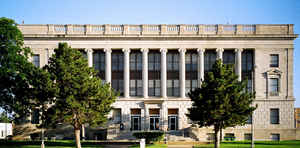Texas Counties
Texas is divided into two hundred and fifty-four counties, more than any other state. Texas was originally divided into municipalities, a unit of local government under Spanish and Mexican rule. When the Republic of Texas gained its independence in 1836, there were 23 municipalities, which became the original Texas counties. Many of these would later be divided into new counties. The most recent county to be created was Kenedy County in 1921. The most recent county to be organized was Loving County in 1931Wilbarger County, Texas
Wilbarger County Education, Geography, and History

Wilbarger County is a county located in the state of Texas. Based on the 2010 census, the population was 13,535. The county seat is Vernon. The county was created in 1858 and later organized in 1881. Wilbarger is named for Josiah Pugh Wilbarger and Mathias Wilbarger, two early settlers.
Etymology - Origin of Wilbarger County Name
Josiah Pugh Wilbarger and Mathias Wilbarger, two brothers and early settlers; Josiah Wilbarger survived being scalped by a group of Comanches
Demographics:
County QuickFacts: CensusBureau Quick Facts
Wilbarger County History
Wilbarger County is a county located in the US state of Texas. The county seat is Vernon. Wilbarger is named for Josiah Pugh Wilbarger and Mathias Wilbarger, two early settlers.
Handbook of Texas Online
Wilbarger County was organized in 1881, and the town of Vernon was designated the county seat; there were only
fifty-six voters in the county at that time. The county grew quickly during the 1880s, despite droughts in 1886 and
1887, the prevalence of prairie dogs, and occasional rampages of stampeding cattle from the seasonal cattle drives
that traveled through the area. In 1886 the Fort Worth and Denver City Railway built into Vernon, connecting the
county to outside markets and encouraging immigration. The importance of the railroad to early development was
recognized by local ranchers, who had donated rights of way. Relations with Indians were friendly during the 1880s.
Quanah Parker and his Comanche followers visited the Doan family frequently, and
Comanche-Kiowa Indians from Oklahoma marketed in Vernon with their government allotments in the 1880s. A newspaper,
the Vernon Weekly Call, was established by D. O. McConnell in 1889. By 1890 there were 720 farms and
ranches, encompassing almost 313,000 acres, in Wilbarger County, and the population had increased to 7,092. Ranching
had become important, and almost 23,000 cattle and 21,000 sheep were reported that year. But crop farming was also
becoming fairly well established in the area. Almost 6,000 acres were planted in corn that year, in addition to
11,000 acres in wheat and 13,000 acres in oats; another 1,600 acres were devoted to cotton. Poultry raising was also
becoming a significant part of the economy, and 50,700 chickens were reported that year. Many farmers and ranchers
suffered reverses during the 1890s. By 1900 almost all the county's sheep had disappeared, only 636 farms remained,
and the population had dropped to 5,759. Nevertheless, crop acreage expanded significantly during this time, and in
1900 over 14,000 acres were planted in corn, almost 34,000 acres in wheat, and almost 4,000 acres in cotton. The
number of cattle increased to 33,000 head that year. The agricultural economy rapidly expanded between 1900 and 1920
as hundreds of new farmers moved into the area. By 1910 there were 1,435 farms and ranches in the county; almost
63,000 acres were planted in corn, and about 20,000 acres in wheat, while more than 55,000 acres were planted in
cotton, which was rapidly becoming the area's most important cash crop. As old ranch lands were converted to crops,
the number of cattle declined, and by 1920 there were only 10,000 cattle in the county. The population grew rapidly
during this period, rising to 12,000 by 1910 and to 15,112 by 1920. Immigration continued during the 1920s, as
cotton cultivation spread rapidly across the county. By 1930 almost 166,000 acres were planted in cotton, while only
1,400 acres were devoted to wheat and 8,000 acres to corn. There were 2,139 farms that year, 1,717 of which were
operated by tenants (see FARM TENANCY). The 1920s also saw the rise of the petroleum industry. The first oil
well in the county had been drilled in 1908, and a producing well followed in 1915, but significant production
awaited the drilling of the South Vernon field in 1923. Soon the oilfield was extended across much of the south part
of the county from the Wichita county line west through the Flukman field. By 1930 there were 24,579 people living
in Wilbarger County More at
John Leffler, "WILBARGER COUNTY," Handbook of Texas Online (http://www.tshaonline.org/handbook/online/articles/hcw09),
accessed January 24, 2016. Uploaded on June 15, 2010. Published by the Texas State Historical Association.
Geography: Land and Water
As reported by the Census Bureau, the county has a total area of 978 square miles (2,533 km2), of which, 971
square miles (2,515 km2) of it is land and 7 square miles (18 km2) of it (0.72%) is water.
Neighboring Counties
Bordering counties are as follows:
- Tillman County, Oklahoma (north)
- Wichita County (east)
- Baylor County (south)
- Foard County (west)
- Hardeman County (west)
- Jackson County, Oklahoma (northwest)
Education







